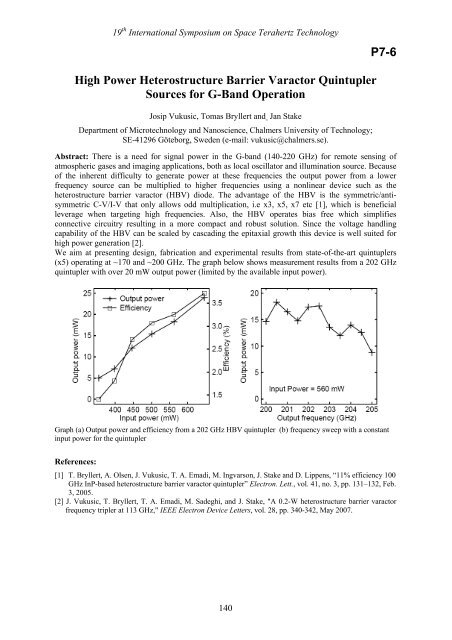Program and Abstract Book - SRON
Program and Abstract Book - SRON
Program and Abstract Book - SRON
You also want an ePaper? Increase the reach of your titles
YUMPU automatically turns print PDFs into web optimized ePapers that Google loves.
19 th International Symposium on Space Terahertz Technology<br />
P7-6<br />
High Power Heterostructure Barrier Varactor Quintupler<br />
Sources for G-B<strong>and</strong> Operation<br />
Josip Vukusic, Tomas Bryllert <strong>and</strong> Jan Stake<br />
Department of Microtechnology <strong>and</strong> Nanoscience, Chalmers University of Technology;<br />
SE-41296 Göteborg, Sweden (e-mail: vukusic@chalmers.se).<br />
<strong>Abstract</strong>: There is a need for signal power in the G-b<strong>and</strong> (140-220 GHz) for remote sensing of<br />
atmospheric gases <strong>and</strong> imaging applications, both as local oscillator <strong>and</strong> illumination source. Because<br />
of the inherent difficulty to generate power at these frequencies the output power from a lower<br />
frequency source can be multiplied to higher frequencies using a nonlinear device such as the<br />
heterostructure barrier varactor (HBV) diode. The advantage of the HBV is the symmetric/antisymmetric<br />
C-V/I-V that only allows odd multiplication, i.e x3, x5, x7 etc [1], which is beneficial<br />
leverage when targeting high frequencies. Also, the HBV operates bias free which simplifies<br />
connective circuitry resulting in a more compact <strong>and</strong> robust solution. Since the voltage h<strong>and</strong>ling<br />
capability of the HBV can be scaled by cascading the epitaxial growth this device is well suited for<br />
high power generation [2].<br />
We aim at presenting design, fabrication <strong>and</strong> experimental results from state-of-the-art quintuplers<br />
(x5) operating at ~170 <strong>and</strong> ~200 GHz. The graph below shows measurement results from a 202 GHz<br />
quintupler with over 20 mW output power (limited by the available input power).<br />
Graph (a) Output power <strong>and</strong> efficiency from a 202 GHz HBV quintupler (b) frequency sweep with a constant<br />
input power for the quintupler<br />
References:<br />
[1] T. Bryllert, A. Olsen, J. Vukusic, T. A. Emadi, M. Ingvarson, J. Stake <strong>and</strong> D. Lippens, “11% efficiency 100<br />
GHz InP-based heterostructure barrier varactor quintupler” Electron. Lett., vol. 41, no. 3, pp. 131–132, Feb.<br />
3, 2005.<br />
[2] J. Vukusic, T. Bryllert, T. A. Emadi, M. Sadeghi, <strong>and</strong> J. Stake, "A 0.2-W heterostructure barrier varactor<br />
frequency tripler at 113 GHz," IEEE Electron Device Letters, vol. 28, pp. 340-342, May 2007.<br />
140
















